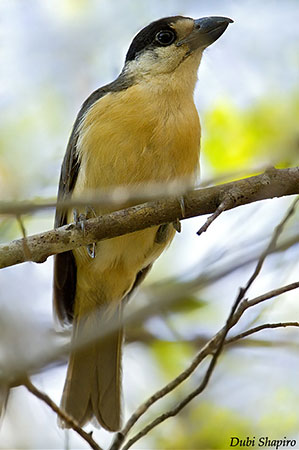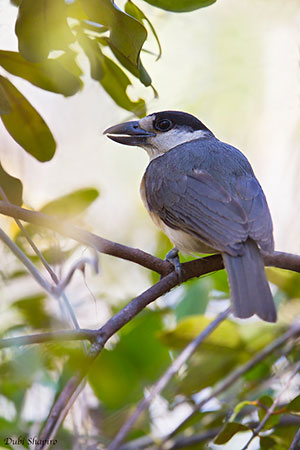
REPRODUCTION OF THIS SPECIES:
The breeding season takes place from end of September or mid-October to early or mid-January.
Both adults build the cup-shaped nest with dead leaves, plant fibres and pieces of bark, and it is covered outside with spider webs. It is placed in tree fork, between 6 and 14 metres above the ground.
The female lays 3-4 white eggs with dark spots. Both adults share the incubation and the nest exchanges are silent. From an observation, the incubation lasts 18 days. The chicks are brooded and fed by both parents. The nestling period is unknown.
PROTECTION / THREATS / STATUS:
The Van Dam’s Vanga has very restricted range and patchy distribution. The habitat is threatened by clearing and burning of forest for agriculture expansion and commercial logging.
The population is estimated to number 1,500/7,000 mature individuals. It is declining owing to destruction of forest habitat.
The Van Dam’s Vanga is currently listed as Endangered.
Fr: Vanga de Van Dam
Ang: Van Dam's Vanga
All: Van-Dam-Vanga
Esp: Vanga de Van Dam
Ita: Vanga di Van Dam
Nd: Van Dams Vanga
Sd: vitstrupig vanga
Photographer:
Dubi Shapiro
Dubi Shapiro Photo Galleries & Dubi Shapiro's Pictures on IBC
Illustrator:
John Gerrard Keulemans (1842-1912)
Illustration origin (Published in 1868)
Text by Nicole Bouglouan
Sources:
HANDBOOK OF THE BIRDS OF THE WORLD Vol 14 by Josep del Hoyo-Andrew Elliot-David Christie - Lynx Edicions – ISBN: 9788496553507
Wildlife of Madagascar par Ken Behrens, Keith Barnes - ISBN: 140088067X, 9781400880676 – Editeur: Princeton University Press, 2016
Birds of Madagascar: A Photographic Guide Par Pete Morris, Frank Hawkins – ISBN: 0300077556, 9780300077551- Editeur: Yale University Press, 1998
Birds of the Indian Ocean Islands Par Ian Sinclair, Olivier Langrand - ISBN: 1868729567, 9781868729562- Editeur: Struik, 2003
The Birds of Africa: Volume VIII: The Malagasy Region: Madagascar, Seychelles, Comoros, Mascarenes - Par Roger Safford, Frank Hawkins – ISBN: 1408190494, 9781408190494- Editeur: A&C Black, 2013
Birds of Madagascar and the Indian Ocean Islands Par Roger Safford, Adrian Skerrett, Frank Hawkins – ISBN: 1472924118, 9781472924117- Editeur: Bloomsbury Publishing, 2015
Madagascar Wildlife: A Visitor's Guide Par Nick Garbutt, Hilary Bradt, Derek Schuurman – ISBN: 1841622451, 9781841622453 - Editeur: Bradt Travel Guides, 2008
Creagus – Bird Families of the World – Vangas - Vanginae
THE VANGAS OF MADAGASCAR by Nick Garbutt
Vanga - From Wikipedia, the free encyclopedia
Home page
Page Order Passeriformes
Van Dam’s Vanga
Xenopirostris damii
Passeriformes Order – Vangidae Family
INTRODUCTION:
The Van Dam’s Vanga is endemic to Madagascar where it occurs in undisturbed dry deciduous forest. It feeds on invertebrates and small vertebrates found in dead wood or clump of dead leaves. It is often observed alone, in pairs or in family groups, but also in mixed-species flocks with other vanga species.
The Van Dam’s Vanga has very restricted range in N/NW Madagascar. It is threatened by habitat loss through destruction of the forest. The species is listed as Endangered.
The name pays tribute to Douwe Casparius Van Dam (1827-1898), a Dutch explorer, nature researcher and museum administrator.
DESCRIPTION OF THE BIRD:
Biometrics:
Length: 23 cm
The Van Dam’s Vanga adult male has dark grey upperparts, slightly darker on mantle. On the upperwing, coverts and flight-feathers are blackish. The uppertail is dark grey.
The underparts are entirely whitish, including chin and throat.
On the head, forehead, crown and ear-coverts are glossy black and contrast strongly with the white collar.
The thick, laterally flattened bill is dark grey. The eyes are blackish. Legs and feet are dark grey.
The adult female (displayed) has whitish to pale buff forehead and lores, whereas cheeks, chin and throat are whitish. Forecrown crown, nape and hindneck are black with blue sheen. The upperparts are tinged brown. On the underparts, breast and belly are sometimes tinged buff. The bare parts are as in male.
The juvenile resembles female but it is usually paler, with brown markings on upperparts and scapulars. Breast and belly are pale brown.


RANGE:
The Van Dam’s Vanga is patchily distributed in N and NW Madagascar. It occurs only at Ankarafantsika and Analamera in the far NW. However, large patches of suitable habitats between these two sites have not yet been investigated for birds.
HABITAT:
The Van Dam’s Vanga frequents the primary dry deciduous forest and the adjacent vegetation, from sea-level to 200 metres of elevation.
CALLS AND SONGS: SOUNDS BY XENO-CANTO
The Van Dam’s Vanga gives typical Xenopirostris whistles “tseeang” or “tsseeeo” starting very high and dropping sharply, repeated several times. It also gives a “tsiiiiep” like the Lafresnaye's Vanga.
We can also hear quieter whistling or clucking sounds, and a low, rather slow “churrachurrachurra”. The contact call is a quiet “whit…whit” often given while foraging.
BEHAVIOUR IN THE WILD:
The Van Dam’s Vanga feeds on invertebrates such as Coleoptera and Blattodea species and other insects and worms. It also takes small vertebrates, mainly chameleons.
It searches for prey by stripping loose bark from branches and tree trunks, and probes in clumps of dead leaves. It gleans and probes in dead wood, breaking loose bark or opening dead branches. It uses its thick, laterally flattened bill to extract larvae from twigs. It may use a foot to grasp leaves while gleaning insects from one of them.
The Van Dam’s Vanga forages alone, in pairs or in small groups, probably family parties. It also joins mixed-species flocks of other vangas, and especially Rufous Vanga.
During the breeding season, the Van Dam’s Vanga is monogamous and territorial. This period coincides with the end of the dry season and continues until the middle of the rainy season. Both mates share the nesting duties.
This species is sedentary on the island, and only performs short-distance flights.
